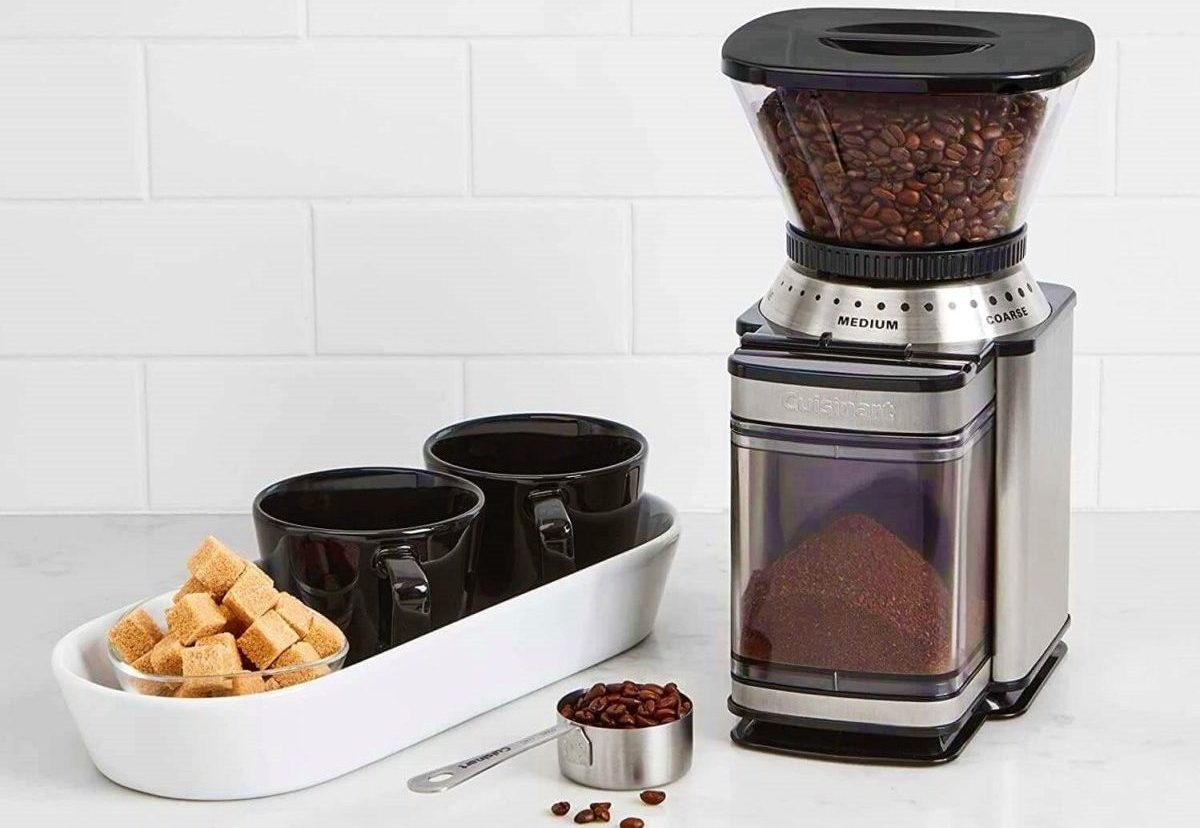How To Grind Coffee Beans Properly: Hey, coffee lovers! Have you ever wondered why your cup of joe doesn’t taste as good as the one from your favorite café? Well, here’s a little secret: the way you grind your coffee beans can make all the difference. Grinding coffee might seem simple, but trust us, it’s a game-changer for flavor.
How To Grind Coffee Beans Properly?
In this article, we will tumble the beans (pun intended!) on the art of grinding coffee. Whether you’re a coffee pro or just starting your caffeine journey, understanding how to grind your coffee beans properly is critical to making that perfect cup.
We’ll break down the basics, explore the different types of grinders, and help you figure out the right grind size for your favorite brewing method.
So, get ready to promote your coffee game because once you nail the grind, your taste buds will thank you with every sip!
Why Does Grind Matter?
The grind of your coffee beans plays a crucial role in determining your coffee’s flavor, aroma, and overall quality. Here are a few key reasons why the grind matters:
- Extraction Rate: Different brewing methods require different grind sizes. If the grind is too fine or coarse for the chosen brewing method, it can affect the extraction rate. Over-extraction (too fine) can produce a bitter taste, while under-extraction (too coarse) may lead to a sour or weak flavor.
- Surface Area: The surface area of the coffee grounds exposed to water influences the extraction process. Finely ground coffee has a larger surface area, allowing for more extraction, while coarsely ground coffee has less surface area. This impacts how quickly the flavors are extracted during brewing.
- Contact Time: The time the water is in contact with the coffee grounds is crucial. For example, espresso requires a short contact time with finely ground coffee, while a French press needs a longer contact time with coarsely ground coffee. The grind size helps control the contact time, influencing the extraction process.
- Flavor Profile: The grind size contributes to the overall flavor profile of the coffee. Different brewing methods highlight specific characteristics of the coffee beans. The right grind size enhances the desirable flavors and aromas, providing a balanced and enjoyable cup of coffee.
- Consistency: Consistency in grind size is important for even extraction. If your coffee grounds have varying sizes, you may have an uneven brew, with some parts over-extracted and others under-extracted. Consistency ensures a uniform flavor throughout your cup.
In summary, the grind size is critical in achieving a balanced and tasty cup of coffee. It’s essential to match the grind size with your chosen brewing method to control the extraction process and bring out the best qualities of your coffee beans.
Types of Coffee Grinds:
Coffee grinds come in various sizes, from extra coarse to extra fine, to suit different brewing methods. Here’s a breakdown of the main types of coffee grinds:
1. Extra Coarse:
-
- Resembles breadcrumbs or chunks of sea salt.
- Typically used for cold brew coffee and some types of French press brewing.
2. Coarse:
-
- Similar to kosher salt.
- Suitable for French press and percolator brewing methods.
3. Medium-Coarse:
-
- Similar to rough sand or sea salt.
- It is often used in Chemex or Clever Dripper brewing.
4. Medium:
-
- Similar to regular sand or table salt.
- Ideal for drip brewers, pour-over methods (like Hario V60), and Aeropress.
5. Medium-Fine:
-
- Similar to granulated sugar.
- Suitable for cone-shaped pour-over brewers (e.g., Kalita Wave) and siphon brewing.
6. Fine:
-
- Similar to powdered sugar or flour.
- Commonly used for espresso machines and stovetop espresso makers (e.g., Moka pot).
7. Extra Fine:
-
- Similar to powdered sugar but smoother.
- It is typically used for Turkish coffee, which requires an extremely fine grind.
Choosing the right grind size is crucial to match the brewing method you plan to use. Using the wrong grind size can result in over-extraction or under-extraction, affecting the taste and quality of your coffee. Adjust your grinder settings based on your preferred brewing method to achieve the best results.
What Grind-For What Maker?
Choosing the right coffee grind for your brewing method is essential to achieving the best flavor. Here’s a guide on which grind size works best for various coffee makers:
1. Coarse Grind:
-
- Best for: French Press, Cold Brew
- Coarse grinds are ideal for methods that involve longer steeping times, allowing water to extract flavors without over-extracting. French press and cold brew require a coarse grind to prevent sediment in the cup.
2. Medium-Coarse Grind:
-
- Best for: Chemex, Clever Dripper
- Slightly finer than coarse, this grind size suits pour-over methods like Chemex and devices like the Clever Dripper, striking a balance between extraction and clarity.
3. Medium Grind:
-
- Best for Drip Coffee Makers, Pour-Over (Hario V60)
- A medium grind is versatile, suitable for drip coffee makers and various pour-over methods like the Hario V60. It promotes even extraction without clogging filters.
4. Medium-Fine Grind:
-
- Best for Cone-Shaped Pour-Over (Kalita Wave), Siphon
- This grind size is a bit finer and is perfect for cone-shaped pour-over brewers like the Kalita Wave. It’s also suitable for siphon brewing, enhancing the extraction process.
5. Fine Grind:
-
- Best for: Espresso Machines, Moka Pot
- Espresso machines and stovetop Moka pots require a fine grind to facilitate the quick extraction of these brewing methods.
6. Extra Fine Grind:
-
- Best for: Turkish Coffee
- Reserved for Turkish coffee, this extremely fine grind ensures a smooth and intense cup, as it allows for quick extraction in the unique preparation process of Turkish coffee.
Remember, the grind size greatly influences the extraction process, and using the right grind for your coffee maker is crucial for achieving the desired flavor and strength in your cup of coffee. Adjusting your grinder settings based on your brewing method is a key aspect of brewing delicious coffee.
Machines for Grinding Beans:
There are various types of machines designed specifically for grinding coffee beans. The selection of a coffee grinder depends on factors like budget, desired grind size, and the brewing method you prefer. Here are the main kinds of coffee grinders:
1. Blade Grinders:
-
- Description: Blade grinders chop coffee beans into particles using a spinning blade. They are typically less expensive.
- Pros: Affordable, compact, and suitable for drip coffee.
- Cons: Inconsistent grind size can produce uneven particles.
2. Burr Grinders:
-
- Description: Burr grinders crush coffee beans between two revolving abrasive surfaces (burrs) to achieve a consistent grind size.
- Pros: Produces a uniform grind size suitable for various brewing methods.
- Cons: It can be more expensive than blade grinders.
3. Manual Grinders:
-
- Description: Manual grinders require hand-cranking to grind coffee beans. They often have burr mechanisms.
- Pros: Portable, quiet, adjustable grind settings, suitable for various brewing methods.
- Cons: Requires manual effort may take longer for large quantities.
4. Electric Burr Grinders:
-
- Description: Similar to manual burr grinders but powered by electricity, providing convenience and speed.
- Pros: Consistent grind size, adjustable settings, efficient.
- Cons: It can be more expensive than manual grinders.
5. Flat Burr Grinders:
-
- Description: Flat burr grinders use two flat, parallel burrs to grind coffee beans.
- Pros: Uniform grind size, efficient, suitable for espresso.
- Cons: It may be pricier than other types.
6. Conical Burr Grinders:
-
- Description: Conical burr grinders use cone-shaped burrs to crush coffee beans.
- Pros: Even grind size, less heat generated, suitable for various brewing methods.
- Cons: It may be more expensive.
When choosing a coffee grinder, consider factors such as grind settings, consistency, ease of cleaning, and the brewing methods you frequently use. Investing in a quality grinder is often considered critical in improving the coffee brewing experience.
How do you grind coffee with a blade grinder?
Grinding coffee with a knife-edge grinder is a straightforward process, but achieving a consistent grind size can be challenging due to the nature of blade grinders. Here’s a step-by-step guide on how to grind coffee using a blade grinder:
What You’ll Need:
- Blade Grinder
- Coffee Beans
- Measuring Scoop
Steps:
1. Measure Coffee Beans:
-
- Determine the amount of coffee you need based on your brewing method. Use a measuring scoop if you want to be precise.
2. Add Coffee Beans to the Grinder:
-
- Open the lid or remove the top of the blade grinder.
- Pour the measured coffee beans into the grinder.
3. Close the Lid:
-
- Securely close the lid of the grinder to prevent coffee beans from flying out during grinding.
4. Grind in Short Bursts:
-
- Turn on the blade grinder and grind the coffee beans in short bursts. Hold down the button for a few seconds, then release and repeat.
- The goal is to achieve a reliable grind size, but the blade grinder may produce uneven particles.
5. Shake or Tap the Grinder:
-
- Pause during grinding to shake or tap the grinder gently. This helps distribute the coffee beans and ensures a more uniform grind.
6. Check Consistency:
-
- Periodically check the consistency of the grind by examining a small portion of the ground coffee. Adjust the grinding time as needed.
7. Grind to Desired Consistency:
-
- Continue grinding in short bursts until you attain the desired grind size for your preparation method. Remember that different brewing methods require different grind sizes.
8. Empty the Grinder:
-
- Once you’ve achieved the desired grind, open the lid and carefully empty the ground coffee into your brewing device or container.
9. Clean the Grinder:
-
- After use, unplug the grinder and clean it according to the manufacturer’s instructions. Blade grinders can retain coffee oils and residue, so regular cleaning is important to maintain the freshness of your coffee.
10. Brew Your Coffee:
-
- Use the freshly ground coffee immediately to brew your favorite cup. The flavor is best when the coffee is brewed shortly after grinding.
While blade grinders are more budget-friendly than burr grinders, keep in mind that they may produce a less consistent grind. Experiment with the grinding time to find the sweet spot for your preferred brewing method.
How to Grind Coffee Beans: Burr Grinders?
Grinding coffee with a burr grinder provides a more consistent grind size compared to blade grinders, making it a preferred choice for coffee enthusiasts. Here’s a step-by-step guide on how to grind coffee using a burr grinder:
What You’ll Need:
- Burr Grinder
- Coffee Beans
- Measuring Scoop
Steps:
1. Adjust Grind Settings:
-
- If your burr grinder has adjustable grind settings, choose the appropriate setting for your brewing method. Different methods, such as French press or espresso, require specific grind sizes.
2. Measure Coffee Beans:
-
- Determine the amount of coffee you need based on your preferred coffee-to-water ratio. Use a measuring scoop for accuracy.
3. Add Coffee Beans to Hopper:
-
- Open the hopper of the burr grinder and pour the measured coffee beans into it.
4. Close Hopper and Set Grind Size:
-
- Close the hopper securely and ensure the grind size setting is appropriate for your brewing method.
5. Turn On the Grinder:
-
- Turn on the burr grinder. Some grinders have a timer or a button you press and hold to start the grinding process.
6. Wait for Grinding to Complete:
-
- Allow the grinder to complete the grinding process. Burr grinders are designed to provide a consistent grind size, and the process may take a bit longer than with blade grinders.
7. Check Consistency:
-
- Open the hopper and inspect the ground coffee. Burr grinders generally produce a more uniform grind size, but it’s still a good idea to check for consistency.
8. Empty the Ground Coffee:
-
- Once grinding is complete, carefully remove the ground coffee from the grinder. Use it immediately for the freshest flavor.
9. Clean the Grinder:
-
- After each use, unplug the grinder and clean it according to the manufacturer’s instructions. Regular cleaning helps maintain the grinder’s performance and prevents the buildup of coffee oils and residue.
10. Brew Your Coffee:
-
- Use the freshly ground coffee to brew your favorite cup. The quality and consistency of the grind from a burr grinder contribute to a more flavorful and balanced coffee.
Using a burr grinder allows you to have more control over the grind size, resulting in a better extraction and overall improved coffee experience. Adjust the grind settings based on your brewing method and experiment to find the perfect grind for your taste preferences.
How To Grind Coffee Beans Properly:
Our favorite grinding solutions are here. Let’s find their advantages.
Our First Recommendation For The Best Coffee Grinder:
Bodum BISTRO Blade Grinder, Electric Blade Coffee Grinder, Black:
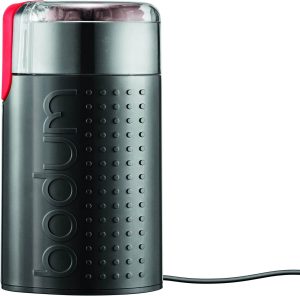
Introduction:
You are introducing the Bodum BISTRO Blade Grinder, an electric marvel designed to elevate your coffee brewing experience. If you’re a coffee enthusiast who values the freshness and aroma of ground beans, this grinder is a game-changer.
Crafted with precision and convenience in mind, the Bodum BISTRO Blade Grinder is here to transform your coffee ritual into a daily delight. Explore its features, benefits, and a few considerations to make an informed decision.
Product Description:
The Bodum BISTRO Blade Grinder boasts a sleek, compact design that effortlessly grinds coffee beans to your desired consistency. Its generous 3-ounce capacity caters to single-cup and small-batch brewing needs.
The clear lid lets you monitor the grinding process, ensuring you achieve the perfect grind for your preferred brewing method. Its stainless steel blades deliver precision grinding, maintaining your favorite coffee beans’ rich flavors and aromas.
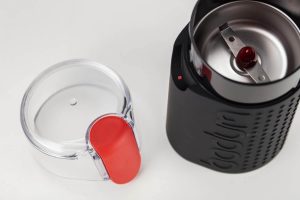
Highlighted Features:
- Electric Blade Grinder: Powered by a robust electric motor, the Bodum BISTRO ensures quick and efficient grinding, saving you valuable time in your morning routine.
- 3-Ounce Capacity: Ideal for personal use or small gatherings, the grinder’s 3-ounce capacity strikes the right balance between convenience and practicality.
- Transparent Lid: The transparent lid not only adds a visual element to the grinding process but also allows you to monitor the consistency of the grind.
Pros:
- Compact Design: Perfect for kitchens with limited counter space.
- Ease of Use: Simple one-button operation for hassle-free grinding.
- Affordability: Offers a budget-friendly option for coffee enthusiasts.
Cons:
- Inconsistent Grind: Some users have reported a tendency for the grinder to produce uneven grinds, impacting the overall brewing experience.
- Noise Level: Like many electric grinders, the Bodum BISTRO can be relatively noisy during operation.
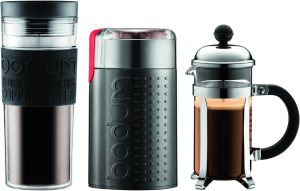
Conclusion:
In conclusion, the Bodum BISTRO Blade Grinder is a reliable and affordable option for coffee lovers seeking a convenient way to grind beans at home. Its compact design, ease of use, and transparency during the grinding process make it a user-friendly addition to any kitchen.
However, potential buyers should be aware of its tendency for inconsistent grinding and the associated noise level. If you prioritize convenience and are willing to overlook these considerations, the Bodum BISTRO could be the perfect friend for your daily coffee ritual.
Explore the world of freshly ground coffee with the Bodum BISTRO Blade Grinder today.
Our Second Recommendation For The Best Coffee Grinder:
CUISINART Coffee Grinder, Electric Burr One-Touch Automatic Grinder with18-Position Grind Selector:
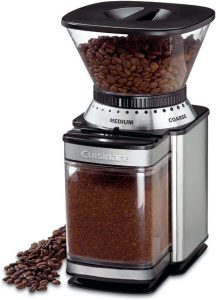
Introduction:
Meet the CUISINART Coffee Grinder, an Electric Burr One-Touch Automatic Grinder that brings precision and customization to your coffee grinding experience. Considered with a sleek stainless steel exterior and advanced features, this grinder is a testament to CUISINART’s commitment to delivering quality coffee appliances.
Whether you’re an avid coffee connoisseur or enjoy a fresh cup in the morning, the CUISINART DBM-8P1 is poised to elevate your coffee brewing game.
Product Description:
The CUISINART DBM-8P1 is a powerful electric burr grinder that provides an effortless way to achieve the perfect grind for your coffee. The stainless steel design adds a touch of elegance to your kitchen and ensures durability. The 18-position grind selector allows you to customize your coffee beans’ coarseness, catering to various brewing methods.
With its one-touch operation, this grinder simplifies the grinding process, making it accessible even for those new to coffee craftsmanship.
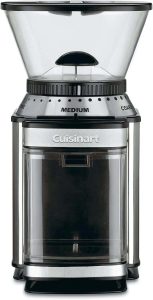
Highlighted Features:
- Electric Burr Grinder: The burr mechanism ensures a consistent grind size, unlocking the full flavor potential of your coffee beans.
- 18-Position Grind Selector: Tailor your coffee grind to suit your preferred brewing method, whether French press, espresso, or drip coffee.
- One-Touch Operation: Simplifies the grinding process, making it user-friendly for novice and experienced coffee enthusiasts.
Pros:
- Consistent Grind: The burr grinder mechanism delivers uniform grind sizes for better extraction of flavors.
- Customization: The 18-position grind selector offers various options to accommodate multiple coffee brewing methods.
- Stainless Steel Design: Not only durable but also adds a stylish touch to your kitchen countertop.
Cons:
- Bean Hopper Size: Some users find the bean hopper relatively small, requiring more frequent refilling, especially for those who brew large quantities.
- Cleaning Challenge: The grinder can be challenging to clean thoroughly, requiring attention to detail to maintain optimal performance.
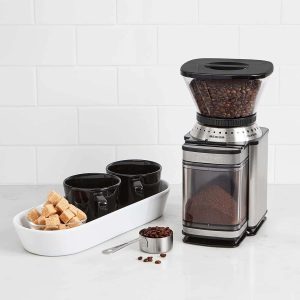
Conclusion:
In conclusion, the CUISINART DBM-8P1 stands out as a reliable and versatile electric burr grinder, offering a range of customization choices to meet the unique preferences of coffee enthusiasts. Its consistent grind, stylish design, and user-friendly features make it a strong contender in coffee grinders.
However, potential buyers should consider the relatively small bean hopper size and the cleaning challenges associated with this model. If you value precision in your coffee brewing and are willing to address these considerations, the CUISINART Coffee Grinder could be the perfect addition to your kitchen arsenal, ensuring a delightful and customizable coffee experience every time.
Our Third Recommendation For The Best Coffee Grinder:
Rancilio Rocky Espresso Coffee Grinder:
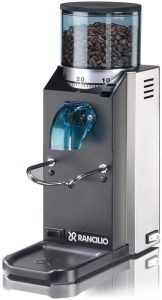
Introduction:
Enter the world of precision coffee grinding with the Rancilio Rocky Espresso Coffee Grinder. Designed by the renowned Italian brand Rancilio, this grinder is a testament to craftsmanship and dedication to the art of espresso. If you’re a discerning coffee enthusiast or a budding barista, the Rancilio Rocky promises to deliver the perfect grind to elevate your espresso experience.
Product Description:
The Rancilio Rocky Espresso Coffee Grinder is a robust and reliable companion for anyone serious about their espresso. With its commercial-grade burrs and sturdy construction, this grinder is built to survive the demands of a busy coffee shop or the passionate home brewer.
The grind adjustment ensures precise control over the grind size, allowing you to dial in the perfect consistency for your espresso shots.
The tinted hopper and grounds container add a touch of style and protect your coffee beans from harmful UV rays.

Highlighted Features:
- Commercial-Grade Burrs: The Rancilio Rocky features 50mm flat burrs that provide consistent and uniform grinding for a superior espresso extraction.
- Stepless Grind Adjustment: Fine-tune your grind size with infinite adjustments, giving you unparalleled control over the brewing process.
- Doserless Design: The grinder’s design minimizes coffee waste and ensures that each dose is freshly ground for maximum flavor.
Pros:
- Commercial Quality: It is built with durable materials and components, making it suitable for home and commercial use.
- Precise Grind Control: The grind adjustment allows you to achieve the exact grind size needed for your espresso machine.
- Doserless Convenience: The design eliminates the need for a dosing chamber, reducing coffee waste and ensuring freshness in every dose.
Cons:
- Noise Level: Some users find the Rancilio Rocky relatively noisy during operation, which may be a consideration for those who prefer quieter appliances.
- Size and Weight: This grinder is relatively large and heavy, which may challenge kitchens with limited counter space.
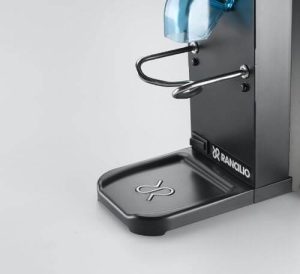
Conclusion:
In conclusion, the Rancilio Rocky Espresso Coffee Grinder is a powerhouse in espresso grinders. Its commercial-grade components, precise grind control, and design make it a favorite among coffee enthusiasts who demand excellence in every shot. However, potential buyers should know the grinder’s noise level and substantial size.
If you’re serious about achieving the perfect espresso at home and can accommodate its size, the Rancilio Rocky investment promises to bring the cafe-quality experience to your kitchen, one perfectly ground shot at a time.
Conclusion:
In conclusion, mastering the art of grinding coffee is a key step towards brewing a perfect cup. Understanding the importance of grind size, choosing the right grinder, and adjusting settings according to your brewing method is fundamental to pursuing a flavorful and aromatic coffee experience.
Whether you’re using a blade grinder for its simplicity or a burr grinder for precision, the key is consistency. Experimenting with grind sizes and paying attention to the nuances of flavor that different grinds bring to your cup will allow you to tailor your coffee to your unique preferences.
Remember, the journey to the perfect grind is personal and may require some trial and error. Embrace the process, refine your technique, and savor the moments as you fine-tune your coffee brewing ritual. With the proper knowledge and equipment, you’ll grind coffee properly and unlock a world of rich and nuanced flavors that will make each cup a delightful experience.
So, take the time to grind with care, and you’ll be rewarded with a consistently exceptional cup of coffee that reflects your passion for the craft. Happy brewing!

